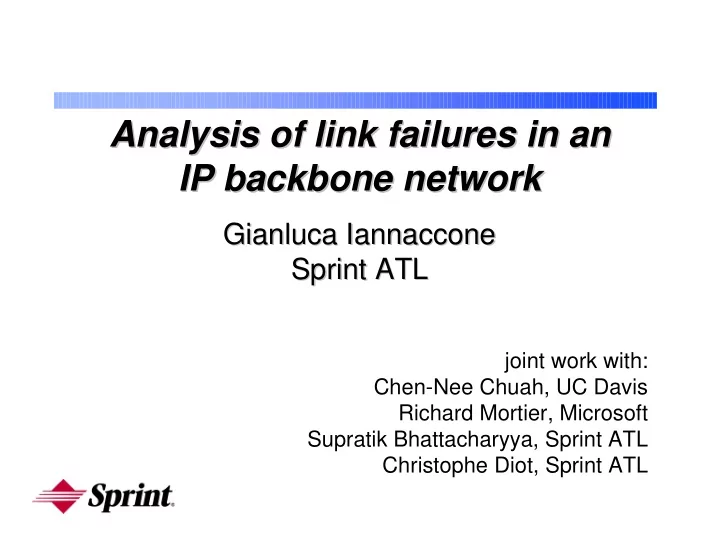

Analysis of link failures in an Analysis of link failures in an IP backbone network IP backbone network Gianluca Iannaccone Gianluca Iannaccone Sprint ATL Sprint ATL joint work with: Chen-Nee Chuah, UC Davis Richard Mortier, Microsoft Supratik Bhattacharyya, Sprint ATL Christophe Diot, Sprint ATL
Motivation Motivation • Today’s Service Level Agreements: – Performance in terms of delay and packet loss – Availability in terms of “port availability” • Need to introduce a “service availability” metric: – Would permit to compare VoIP/VPN services to standard telephone networks Question: Question: “How often does a router have no forwarding “How often does a router have no forwarding information for any given destination prefix?” information for any given destination prefix Internet Measurement Workshop November 7th, 2002 2
Methodology Methodology • Frequency and duration of link failures – Recorded IS-IS routing updates – Python Rout(e)ing Toolkit to listen to failures – 4 months of data (Dec 2001 – Mar 2002) – U.S. inter-PoP links – Failures less than 24hrs long Internet Measurement Workshop November 7th, 2002 3
Network- -wide Time Between Failures wide Time Between Failures Network Average: ~ 34min Average: ~ 34min 50%: ~ 3min 50%: ~ 3min Internet Measurement Workshop November 7th, 2002 4
Breakdown by time of the day (EDT) Breakdown by time of the day (EDT) Higher incidence of failures at night. Likely due to maintenance. Internet Measurement Workshop November 7th, 2002 5
Causes of failures Causes of failures • Duration may give a hint • Some speculations: – Long (>1hour): fiber cuts, severe failures – Medium (>10min): router/line card failures – Short (>1min): line card resets – Very Short (<1min): optical equipment Internet Measurement Workshop November 7th, 2002 6
Does the duration give any hint? Does the duration give any hint? ~ 94% < 1hr ~ 94% < 1hr ~ 80% < 10min ~ 80% < 10min ~ 50% < 1min ~ 50% < 1min Internet Measurement Workshop November 7th, 2002 7
Controlled failure experiment Controlled failure experiment Internet Measurement Workshop November 7th, 2002 8
Impact of a failure: 7 steps to re- -route traffic route traffic Impact of a failure: 7 steps to re 1. Detect link down <100ms 2. Wait to filter out transient flaps 2s 3. Wait before sending update out 50ms 4. Processing & flooding the update ~10ms/hop 5. Wait before computing SPF 5.5s 6. Compute shortest paths 100-400 ms � exp. protocol convergence: 5.1s / 5.9s 7. Update the routing tables ~20 pfx/ms � exp. service convergence: 1.5s / 2.1s � exp. total disruption: 6.6s / 8.0s � � � Internet Measurement Workshop November 7th, 2002 9
Conclusion Conclusion • Link failures are part of everyday operations • Majority of failures are short-lived • Disruption in packet forwarding depends on – routing protocol dynamics and implementation – router architecture – too many timers and interactions among different components • Need to develop link failure model: – define IP service availability – need more points (4 months are not enough) Internet Measurement Workshop November 7th, 2002 10
Recommend
More recommend